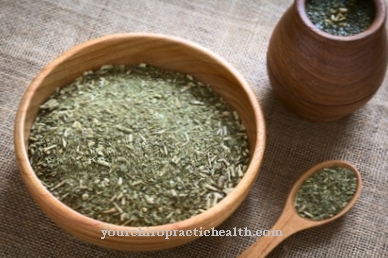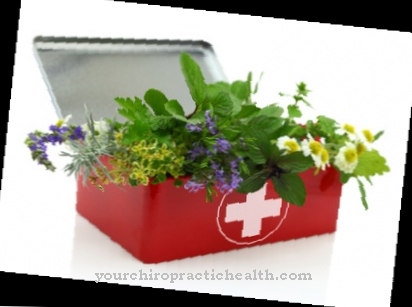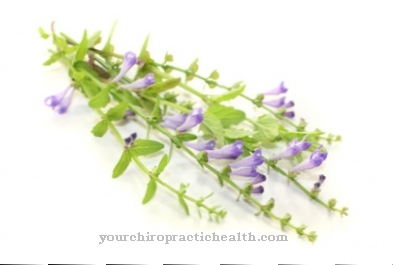The ancient Greeks already knew it chervil. The Romans used it as a food spice and medicine. The fact that the aromatic culinary herb is not only a tasty spice, but also has medicinal properties, has almost been forgotten today.
Occurrence & cultivation of the chervil

The elongated or egg-shaped leaves of the real chervil are usually multi-pinnate. Like wild parsley, they can be consumed raw or cooked. In May / June, many tiny white flowers open on the double-ended inflorescences. The chervil fruits (elongated dark brown double achenes) are formed in autumn.
If you want to collect the wild chervil for medicinal purposes, you should cut the herb in August / September and dry it. If you are not familiar with it, it is best to bring a specialist with you, as the edible chervil varieties can easily be confused with the poisonous hemlock and the sweet umbel (Spanish chervil). The kitchen chervil has a sweet taste with a hint of anise and parsley.
It is used in dried form for healing applications. Chervil is native to southern Russia, western Asia and south-eastern Europe. Today the versatile herb is also found in its wild forms all over Europe. It prefers sunny locations with slightly moist, humus-rich loamy soil and grows on fallow land, in sparse forests and on the edges of forests.
Effect & application
Chervil contains bitter substances, flavonoids, apiin, tannins, glycosides, essential oil, unsaturated fatty acids, isoanethol, chavibetol, lots of iron, zinc, magnesium, potassium and lots of vitamin C and provitamin A. It is used internally as tea and fresh pressed juice and externally used in the form of compresses and poultices.
Chervil has a hematopoietic, anti-inflammatory, antioxidant, immune-boosting, antihypertensive, circulatory, diuretic, antipyretic, expectorant, metabolism-stimulating, antiseptic, appetite-stimulating, digestive, antipruritic and nerve-soothing effect.
To prepare the diuretic and detoxifying chervil tea, a tablespoon of dried herb is poured with 250 milliliters of boiling water. After ten minutes, the tea is strained. The user drinks three cups a day over a period of three to four weeks if he wants to take him on a spring cure. To make chervil schnapps, the patient pours a handful of fresh chervil leaves into a wide-necked bottle and then pours one liter of grain onto it.
A few days later he pours the now green liquid through a clean cotton cloth and fills it into another bottle. Chervil products are usually well tolerated. In particularly sensitive people, however, gastric mucous membrane irritation can occur. Pregnant women should generally not consume chervil (not even as a herb).
Raw chervil - if it is consumed fresh in large quantities - can cause photodermatitis: The furocoumarins contained in the plant cause the skin to be more sensitive to light.
Importance for health, treatment & prevention
Chervil has a purifying and blood-purifying effect, so it is well suited for detoxification treatments (liver, gall bladder, intestines, urinary tract organs). Thanks to the essential oils and bitter substances, the kidneys and intestinal function are stimulated and metabolic waste products, food toxins and drug residues are expelled from the body. Kidney infections are relieved by the anti-inflammatory properties of chervil.
In addition, the ingredients stimulate digestion, so that stubborn constipation and gas are eliminated. Thanks to its high fiber content, the chervil can even stop diarrhea: The fibers swell in the intestine and thus provide more stool volume. At the same time, they bind excess cholesterol and lower the blood lipid level.
Thanks to the dehydrating properties of chervil, inflammatory substances are removed more quickly and infections and inflammations in the body are alleviated. Water retention in the tissue is reduced. Because of their expectorant properties, isoanethol and chavibetol ensure that even stubborn bronchial mucus is loosened and coughed up.
The high content of vitamin C, provitamin A and flavonoids strengthens the immune system, causes the formation of new defense cells and protects cells and organs from the cell-destroying free radicals. The metabolism is stimulated, the energy production in the cells increased. Unsaturated fatty acids contained in chervil, such as petroselinic acid, have nerve-calming and sleep-promoting effects and also improve memory.
Patients suffering from eczema or acne and burn victims can relieve their discomfort with chervil compresses and by dabbing with the decoction. The active substances contained in the chervil then have an antiseptic and wound healing effect and promote the formation of new skin cells on the affected area. For rheumatic complaints and gout nodules, compresses with chervil decoction, which are simply placed on the painful area of skin or the joint, help.
Insect bites are simply dabbed with some decoction to relieve the itching. With chervil press juice compresses, beta-carotene, vitamin C, flavonoids, bitter substances, essential oil, iron, magnesium and zinc also have a wrinkle-smoothing effect. To do this, the user simply wets the affected area with the freshly squeezed chervil juice. Swollen eyelids are treated by placing the compresses on the eyes for 15 minutes. He chews some fresh chervil leaves to prevent bad breath.
























.jpg)



